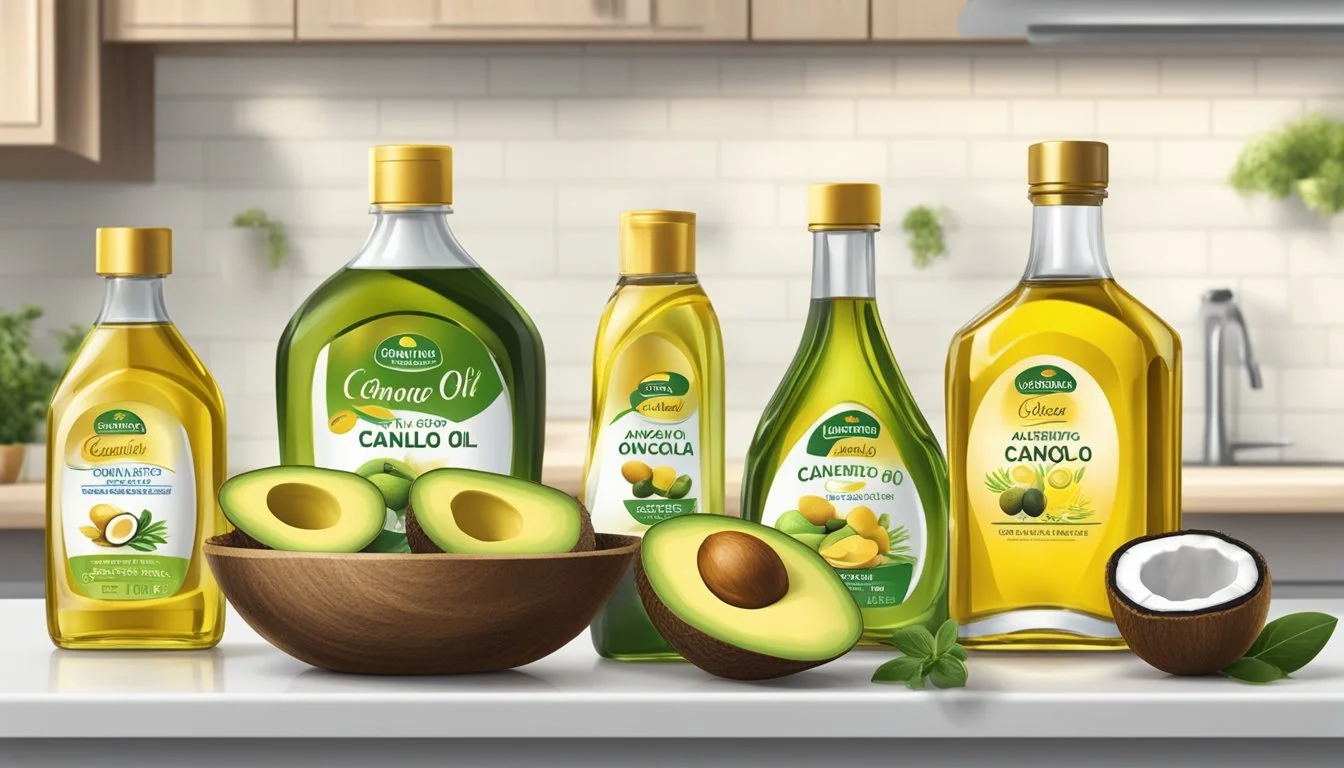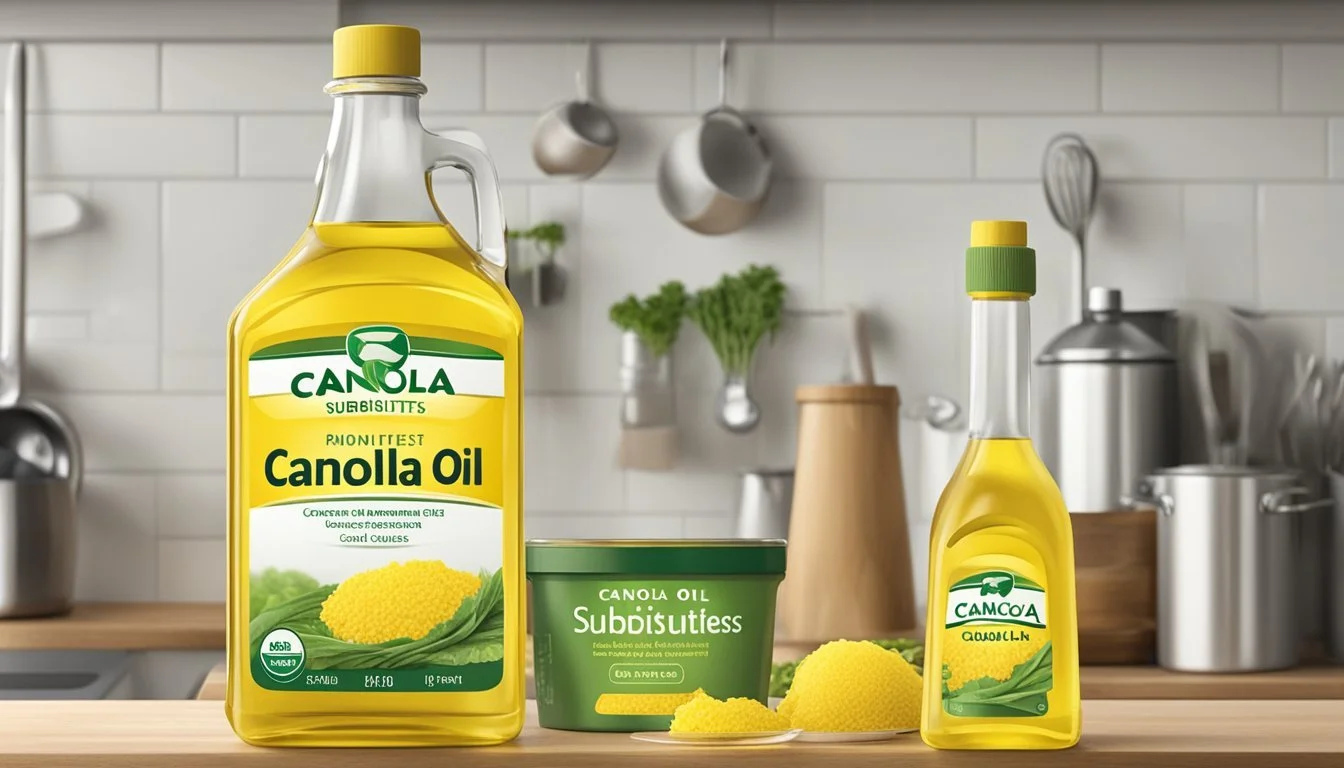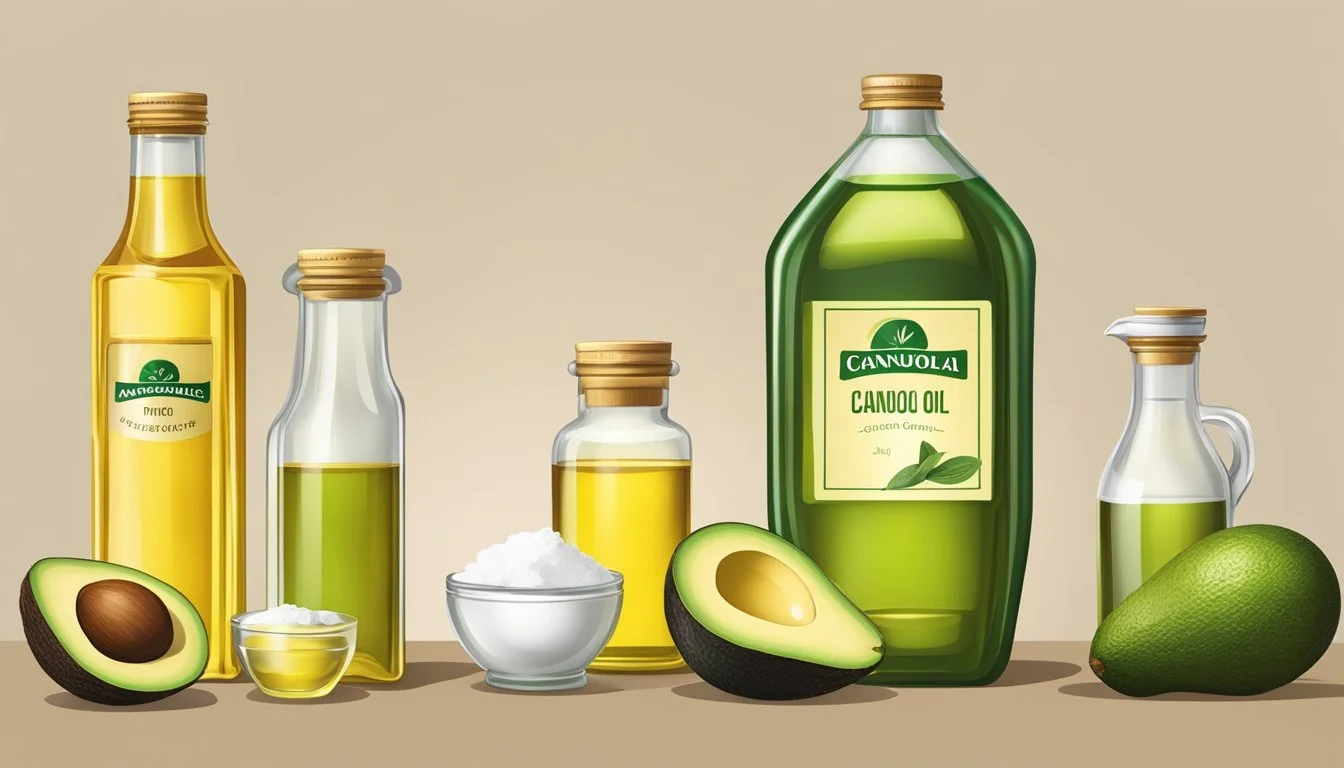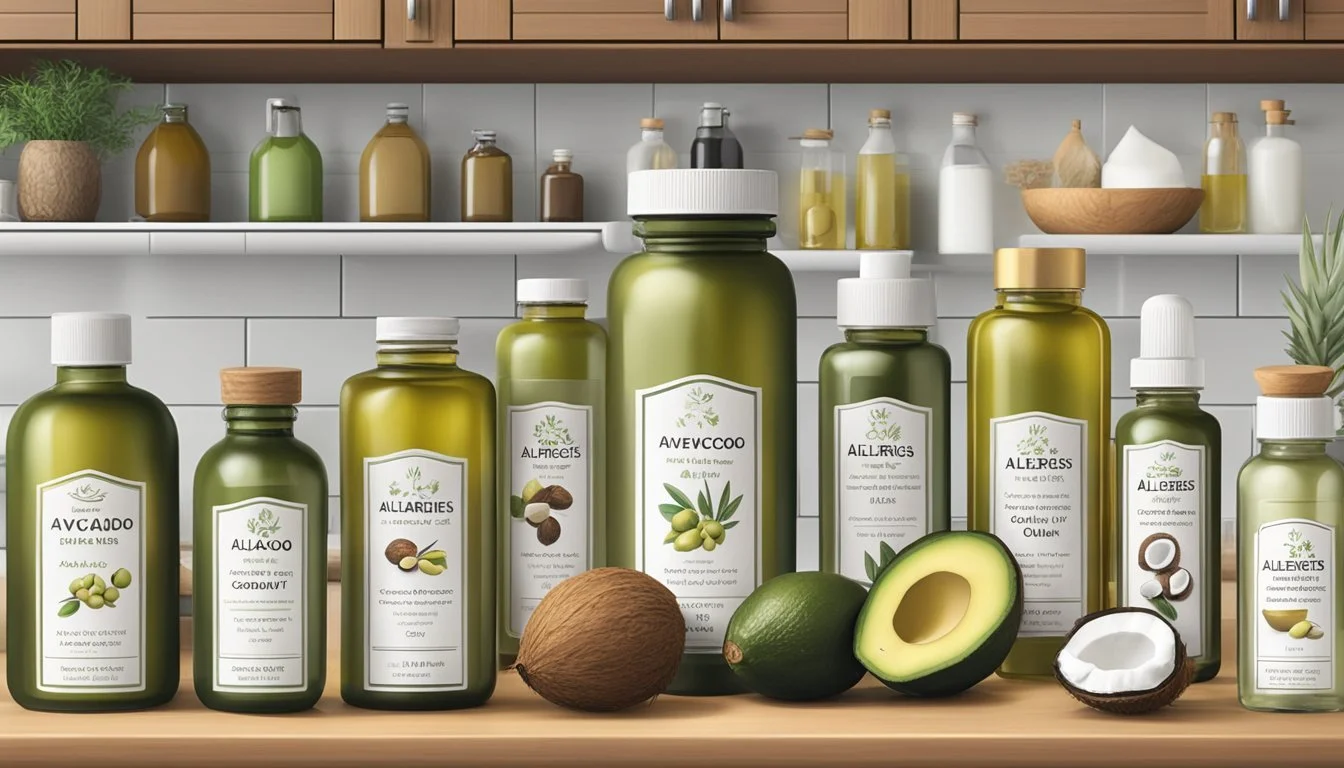Canola Oil Substitutes
Top Alternatives for Your Cooking Needs
Canola oil is a staple in many kitchens due to its mild flavor and high smoke point, making it a versatile cooking oil for frying, baking, and sautéing. However, with growing health concerns and dietary preferences, many individuals seek substitutes for canola oil that offer a similar performance in the kitchen. Alternative oils each come with their unique profiles and advantages, allowing home cooks and professionals alike to tailor their oil choice to their nutritional requirements and recipe needs.
There is a range of substitute oils that can be used in place of canola oil for various cooking applications. Oils such as avocado oil, safflower oil, and sunflower oil are healthy alternatives that maintain the integrity of dishes while providing distinct nutritional benefits. Avocado oil, although sometimes more expensive, has a richer taste and is high in monounsaturated fats, which are beneficial for heart health. Safflower oil, praised for its neutral flavor, closely resembles canola oil in its nutrition profile and can be utilized for high-heat cooking. Sunflower oil is another popular choice, light in flavor, and able to withstand high temperatures without compromising its qualities.
When selecting a canola oil substitute, it is important to consider the oil’s flavor, smoke point, and health benefits to ensure it aligns with the intended culinary use and dietary preferences. With the right substitute, dishes can attain the desired taste and texture while optimizing health benefits, making meal preparation both a delicious and health-conscious endeavor.
Understanding Canola Oil
In exploring canola oil, it's important to recognize its unique properties that make it a go-to option for various cooking practices, its nutritional profile rich in unsaturated fats, and its perceived health benefits due to the presence of omega acids.
Properties of Canola Oil
Canola oil is characterized by a neutral flavor and neutral taste, which makes it a preferred oil in the kitchen as it doesn't alter the flavor of foods. It has a high smoke point of around 400°F (204°C), which allows for versatile uses such as frying and baking without producing harmful compounds that can occur when an oil smokes.
Common Uses of Canola Oil
It is considered a versatile cooking oil due to its ability to withstand high temperatures and its subtle flavor. Commonly, canola oil is used for:
Frying: Given its high smoke point.
Baking: Its neutral taste doesn't interfere with the flavor of baked goods.
Salad dressings: Due to its light texture.
Sautéing and grilling: As it doesn't smoke at medium-high temperatures.
Health Benefits
Canola oil is high in unsaturated fats, which include both omega-3 and omega-6 fatty acids, regarded as heart-healthy options. The balance of these fats is considered beneficial to maintaining healthy cholesterol levels, which supports cardiovascular health. However, it is important to consume these fats as part of a balanced diet.
Canola Oil in Cooking
Canola oil, with its neutral flavor and a high smoke point, is a versatile ingredient in the kitchen, ideal for a range of preparations from high-heat cooking to baking and dressings.
High-Heat Cooking with Canola Oil
Canola oil is a popular choice for high-heat methods like sautéing, frying, and grilling because it can withstand temperatures up to around 400 degrees Fahrenheit without smoking or breaking down. Its light texture and mild flavor ensure it doesn’t overpower the dish's natural flavors.
Smoke Point: ~400°F (204°C)
Flavor Profile: Neutral
Common Uses:
Sautéing
Pan-frying
Canola Oil in Baking
In baking, canola oil is often chosen for its ability to keep cakes, muffins, and cookies moist without adding a pronounced flavor. Its liquid state at room temperature makes it an ideal fat for creating the desirable texture in baked goods.
Baked Good Examples:
Muffins: Canola oil contributes to a tender crumb.
Cakes: Ensures a moist, delicate texture.
Cookies: Helps create a softer consistency.
Salad Dressings and Marinades
Canola oil's mild taste and light texture make it perfect for salad dressings and marinades, as it allows the flavors of herbs and spices to shine through. Its healthful properties, rich in monounsaturated fats, are an added benefit.
Key Characteristics:
Taste: Mild, does not overpower other flavors
Texture: Light, not overly greasy
Examples:
Salad dressings: Canola oil blends well with a variety of vinegars and seasonings.
Marinades: It helps to tenderize and infuse flavors into meats and vegetables.
Canola Oil Substitutes
When selecting a substitute for canola oil, individuals often consider the intended use in cooking or baking and any dietary restrictions they may have. The alternatives provided can cater to high-heat cooking needs as well as address health and allergy concerns.
Substitutes Based on Use
High-Heat Cooking: For methods like frying or sautéing, oils with high smoke points are necessary.
Safflower Oil: Matches canola oil with a high smoke point of around 510°F and is excellent for grilling and sautéing.
Grapeseed Oil: Offers a high smoke point between 390 to 420°F, making it suitable for frying without altering the food's flavor.
Corn Oil: Comes with a high smoke point comparable to canola, preserving food flavor while supporting various cooking methods.
Baking:
Safflower Oil: It is neutral in flavor, perfect for maintaining the original taste in baked goods.
Dietary Restriction Substitutes
Allergies: Those with allergies to canola or seeking alternatives due to health reasons have several options:
Safflower Oil: A neutral-tasting oil which is often well-tolerated by those with dietary allergies.
Grapeseed Oil: A good source of polyunsaturated fats and vitamin E, beneficial for those with dietary restrictions looking for healthy alternatives.
Corn Oil: Often suitable for those concerned with allergen-free cooking, though it's always important to check for specific dietary requirements.
It is always advisable to consult with a healthcare provider or nutritionist when considering alternatives for dietary restrictions to ensure compatibility with individual health needs.
Substitute Options for Canola Oil
When looking for canola oil substitutions, it’s essential to consider the cooking method and the flavor profile desired in the dish. The following substitutes are carefully selected to cover various culinary needs from frying at high temperatures to baking and preparing cold dishes.
Substitutes for High Smoke Point Cooking
For cooking methods that require high heat, such as sautéing or deep frying, oils with a high smoke point are necessary to prevent burning and the release of harmful compounds.
Safflower Oil: With a smoke point of around 510°F, safflower oil stands out for its neutral flavor and is suitable for high-heat applications.
Sunflower Oil: Another neutral-tasting oil, sunflower oil has a high smoke point close to 450°F, making it an excellent alternative for high-temperature cooking.
Peanut Oil: Known for its ability to handle high heat, peanut oil is ideal for deep frying and adds a slightly nutty flavor to dishes.
Grapeseed Oil: With a smoke point around 420°F, grapeseed oil is versatile for various cooking methods, providing a clean taste.
Substitutes for Baking
Baking requires oils that blend well with other ingredients without overpowering the flavors.
Applesauce: A unique substitute for canola oil in baking, applesauce can provide moisture while reducing fat content. Use equal amounts of applesauce in place of oil for a healthier option.
Butter: For richer flavor, melted butter can be used as a 1:1 substitute for canola oil, enhancing the taste of baked goods.
Substitutes for Dressings and Cold Dishes
Dressings and cold dishes often benefit from oils with distinct flavors or nutritional profiles.
Extra Virgin Olive Oil: Known for its rich flavor, extra virgin olive oil can elevate the taste of dressings and cold dishes while providing healthy fats.
Virgin Olive Oil: Slightly milder than extra virgin, virgin olive oil can be used in dressings for those preferring a subtler olive flavor.
Heart-Healthy Alternatives
For those concerned with heart health, it's important to choose oils with favorable fat compositions.
Avocado Oil: High in monounsaturated fats, avocado oil is a heart-healthy alternative with a high smoke point, making it versatile for cooking and dressings.
Almond Oil: This oil provides a dose of healthy fats and vitamin E, making it a nutritional substitute for canola oil, particularly in raw dishes.
Oils with Specific Flavor Profiles
When substituting canola oil, it's important to consider the flavor profiles of alternative oils, as they can subtly or significantly affect the taste of the dish.
Mild Flavor Oils
Olive Oil: This oil is a staple in many kitchens with a flavor that ranges from fruity to grassy. It's best suited for dressings and low-heat cooking. Olive oil's smoke point varies with its type; extra-virgin has a lower smoke point, while higher grades can be used for sautéing.
Sunflower Oil: Characterized by its light taste, sunflower oil allows the flavors of other ingredients to shine through. It is also appreciated for its high smoke point, making it viable for frying and high-heat applications.
Safflower Oil: With a very subtle taste and high smoke point, safflower oil is optimal for cooking when a neutral background is desired. It excels in grilling, sautéing, and high-heat applications.
Coconut Oil: While often solid at room temperature, coconut oil offers a slightly sweet and nutty profile, which may be more pronounced in certain dishes. Its medium-high smoke point works well in baking or light sautéing.
Nutty and Distinctive Oils
Sesame Oil: Sesame oil delivers a robust, nutty flavor, ideal for Asian cuisines and dressings. Its pronounced taste makes it a finishing oil rather than a cooking base for most dishes.
Almond Oil: Almond oil imparts a mildly sweet and nutty aroma, suitable for both savory and sweet preparations. With its distinct quality, it's typically used to enhance flavors rather than as a direct substitute for canola oil's neutrality.
Fats and Oils Nutritional Comparison
When choosing a cooking oil, one should consider its nutritional content, especially the types of fats and the presence of vitamins and omega fatty acids.
Unsaturated Fats Content
Canola oil and olive oil are high in monounsaturated fats, which can be beneficial for heart health. Sunflower oil, especially high-oleic varieties, also contains significant monounsaturated fats. Soybean oil and corn oil feature a mix of monounsaturated and polyunsaturated fats. These oils offer considerable amounts of unsaturated fats:
Canola oil: Predominantly monounsaturated fats
Olive oil: High in monounsaturated fats
Sunflower oil: High in monounsaturated fats, with polyunsaturated variations
Soybean oil: Balanced monounsaturated and polyunsaturated fats
Corn oil: Moderate monounsaturated with higher polyunsaturated fats
Vitamin E and Omega Content
Vitamin E and Omega fatty acids are essential nutrients found in various oils. Canola oil provides a good source of vitamin E and a balanced omega-3 to omega-6 ratio. Olive oil is known for its vitamin E content and high levels of omega-9 fatty acids. The following list gives a quick comparison:
Canola oil: 2.42 mg of Vitamin E per tablespoon, balanced omega-3/omega-6
Olive oil: Rich in Vitamin E, high in omega-9, low omega-3/omega-6
Sunflower oil: Varieties can differ, some high in vitamin E, generally more omega-6
Soybean oil: Contains Vitamin E and a significant amount of omega-3
Corn oil: Provides Vitamin E, high in omega-6 with lower omega-3 content
Understanding these nutritional aspects can help consumers make informed choices based on their dietary needs and cooking methods.
Considerations for Allergies and Sensitivities
When considering canola oil substitutes due to allergies or sensitivities, it is crucial to understand the specific allergens involved and identify oils that do not provoke adverse reactions.
Allergies Related to Canola Oil
Canola oil originates from the rapeseed, which is a member of the Brassicaceae family—also known as the brassica family. Individuals with allergies to this family, which includes mustard and cabbage, might also react to canola oil. As a derivative of rapeseed oil, organic canola oil undergoes less processing; however, the allergenic potential remains for those sensitive to these plants.
Alternative Oils for Allergy Sufferers
For those seeking alternatives due to allergies, the following oils are worth considering:
Soy Oil: While soy oil is a common substitute, it is paramount to note that soy is a significant allergen for many and should be avoided by individuals with soy allergies.
Safflower Oil: This oil is often praised for its neutrality in flavor and high smoke point, qualities that make it a versatile alternative for individuals without sensitivities to it.
It is always recommended that individuals consult with a healthcare provider before introducing a new oil into their diet, especially when dealing with known allergies or sensitivities.
Sustainability and Production
In the realm of cooking oils, sustainability and the particulars of production are pivotal considerations. This section examines the environmental impact related to oil production and the differences between organic and conventional oil manufacturing processes.
Environmental Impact of Oil Production
Canola Oil: It emerges from rapeseed and its production has been noted for a relatively low emission of greenhouse gases. Rapeseed oil is deemed one of the more sustainable options, due to its modest carbon footprint compared to other vegetable oils.
Water Usage: Conventional production of canola and similar oils requires significant amounts of water, although some newer brands claim considerable reductions in water use.
Land Use: When compared with traditional vegetable oils, canola requires less land. Producers are striving to minimize land use further to enhance sustainability.
Organic Versus Conventional Oils
Organic Oils: They are produced adhering to standards that forbid the use of synthetic pesticides and fertilizers, thereby potentially reducing the environmental toll. Organic canola oil is part of this niche, contributing to a lesser ecological footprint.
Sustainable Practices: Organic farming often incorporates practices like crop rotation and natural pest control, which are viewed as more environmentally benign.
Certifications: For an oil to be labeled as organic, it needs to meet stringent certification requirements ensuring that production processes align with organic standards.
Conventional Oils: These oils are typically mass-produced with the aid of chemical aids to boost yield.
Chemical Usage: In contrast to organic oils, conventional oils often utilize synthetic inputs which can lead to concerns over soil health and biodiversity.
Economic Accessibility: Conventional oils are usually more economically accessible due to larger-scale production and lower costs of synthetic inputs.
Culinary Techniques with Oil Substitutes
Selecting the appropriate canola oil substitute is pivotal for ensuring the desired outcomes in texture and flavor in cooking techniques such as sautéing and baking. Factors like smoke point and inherent richness of the oil influence the final dish.
Sauteing with Substitute Oils
When sautéing, it's essential to consider the smoke point of an oil — the temperature at which it begins to smoke and break down. Canola oil, with its high smoke point of approximately 400°F, is a popular choice for sautéing. Sunflower oil, also with a high smoke point of about 450°F, serves as an excellent alternative, maintaining a neutral flavor profile. It can be employed in a 1:1 ratio when substituting for canola oil.
Oil Type Smoke Point Flavor Profile Best Used For Canola Oil 400°F Neutral General sautéing Sunflower Oil 450°F Neutral Sautéing at higher temperatures
Safflower oil is another suitable substitute with an even higher smoke point of approximately 510°F. Though it may carry a slight price increase, its neutral taste and heat tolerance make it ideal for high-temperature cooking.
Enhancing Richness in Baked Goods
For baking, richness and texture of the finished product are often paramount. Canola oil is frequently used in baked goods for its neutral taste and moist texture. Avocado oil is a viable substitute for canola oil in baking due to its healthy fats, though it does carry a more distinctive flavor which may be noticeable in the final product. When using avocado oil, one should be aware of its slightly nutty taste, yet it can be incorporated in the same quantity as canola oil.
Oil Type Smoke Point Flavor Profile Best Used For Canola Oil 400°F Neutral General baking Avocado Oil 520°F Slight nutty flavor Enhancing richness in goods
Substitutes like grapeseed oil, with a high smoke point and light flavor, may also contribute to a moist and rich texture in baked items, complementing canola oil in various recipes.
Final Considerations on Canola Oil Substitutes
When considering substitutes for canola oil, one must take into account factors such as flavor profiles, smoke points, and health aspects. Canola oil is favored for its neutral flavor and high smoke point, making it a versatile choice for a variety of dishes, including salad dressings and high-heat cooking methods.
Substitute Options:
Avocado Oil: Rich in monounsaturated fat and a healthy substitute with a high smoke point. Ideal for baking and frying, but more expensive.
Olive Oil: Great for dressings and low-heat cooking with a distinct taste.
Safflower Oil: A good match for canola oil due to its neutral flavor and high smoke point.
Health Considerations:
Canola oil is low in saturated fat and has been associated with reduced risk of coronary heart disease. Substitutes should ideally have a similar nutritional profile, prioritizing oils high in monounsaturated fats and low in saturated fats.
Culinary Uses:
Cooking oils serve various functions in recipes. For frying or sautéing, one needs an oil with a high smoke point.
Vegan recipes may require oil with specific qualities. It is important that the substitute aligns with vegan principles.
Caloric Value:
It’s essential to note that most cooking oils have a similar calorie content, so substitutions won't significantly alter the calorie count of the dish.
In summary, when selecting a canola oil substitute, individuals should consider the specific requirements of the dish, health implications, and personal dietary choices. An appropriate substitute is one that maintains the integrity of the recipe while also aligning with the nutritional and flavor preferences of the chef.







